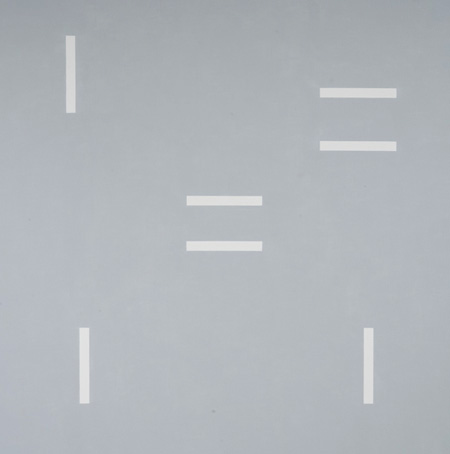
Continuing through November 17, 2012
Edith Baumann’s deceptively minimal paintings are the product of a slow layering process that hides its own complexity in the same way that a tree trunk or a pearl hides the vagaries of an organism’s interaction with its environment under what to a cursory glance is a generic exterior. In both cases, what appears pared down to a simple geometric order is actually the product of the accumulation of near countless minute chaotic events into each of which seeps a little bit of chance or what the French call hasard, a word that reminds us of chance’s association with risk.
To achieve what may at first sight appear to be monochromatic passages in her paintings, Baumann applies multiple layers of acrylic glazes, each minutely adjusting the hue and saturation until she achieves a chromatic and spatial effect she deems right. Consequently, these are paintings that resist photographic summarization, which yields a graphic impression devoid of the subtle complexities that vivify direct observation. In this, they recall the paintings of Charles Christopher Hill, which in turn owe a debt to the mid-‘60s “finish fetish” aesthetic.
In conversation, Baumann has linked the "Jazz Notes" series to meditation and the painting of mandala shapes, but formally these works appear to be what I’m tempted to call exploded Mondrians, with the modernist grid coming unbolted and dispersing centripetally in slow motion. In the process, an airiness enters them that is quite alien to Mondrian’s tight choreography but perhaps connotative of SoCal casualness and light. If Mondrian was drawn to boogie-woogie, Baumann is an enthusiast of smooth jazz. If that seems like a disparaging observation, I would suggest that it is only so to the extent that the association of art with calm and pleasure reaching back to Matisse has fallen into disrepute. Modernism has accustomed us to demand difficulty and self-reflexivity from art. Postmodernism has trained us to smirk at everything other than smirking, so this works' hard-won evocation of euphoric space might very well be dismissed by some as soporific.
However, the dervish is in the details: in the way that Baumann has adjusted the colors of her bars and the space that surrounds them to achieve contrast without allowing them to separate into distinct planes; in the way the bars constellate into local groupings and at the same time remain associated with the overall pattern; in the play between symmetry and its subversion; in the carefully calibrated positioning of her bars in relation to both the center and edges of the paintings so as to allow the decentering of her compositions while restraining them from flying apart. None of this is something that can be achieved (or appreciated) without a fully awakened engagement.
Baumann has been working in this vein since the ‘80s. The sense of ease and calm in her work is the product of a dogged and intense discipline. In conversation with Joan Quinn, she has revealed that the collective title "Jazz Series," which eventually became "Jazz Notes," was meant to help viewers “get into” the paintings. As with all such verbal hand-holding, this tends to achieve the opposite of what it intends: inattention as opposed to engagement. If jazz needed to be invoked at all, it might have been better done through reference to specific compositions. Be that as it may, they are beautiful and, at their best, ineffable paintings. The fact that photographs do not do them justice is an added bonus. They promise surprises.
Published courtesy of ArtSceneCal ©2012
